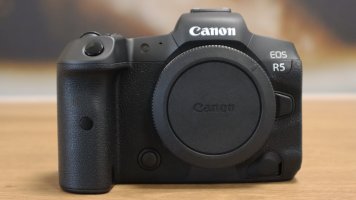---
Now about that frame grabbing thing .... Give it a try!
Set your Canon to 24 fps at 10 bits per colour channel or higher and at a high bit rate (i.e. at least 75 megabits to 150 megabits per second or more!) and use CLOG, CLOG2 or CLOG3 dynamic range preservation recording (i.e. do not use a burned in LUT!)
Capture your video at full 24 fps DCI 4K or DCI 8K. (or UHDTV 4K/8K)
Load into Blackmagic Resolve.
If you are NOT using a pre-defined LUT (i.e. Cinema-oriented Colour Lookup Table), then go into the luminance levels adjustment section of your colour correction screen and raise your deep shadows by 10% to 15% until you just START BARELY start seeing the fine details in dark shadowy rocks, tree bark, details in shadowy human faces, bricks, road pavement, etc. You just need to barely start seeing those fine details, then back of a tiny bit so you preserve a WIDE latitude from dark to bright in your captured footage.
For your bright highlights, actually REDUCE THEM by about 5% to 10% because Canon tend to record HOT. In the clouds, you should still see puffy white and NOT dull grey and you should STILL see the fluffy fine details of said clouds. You reduce the highlights UNTIL they BARELY start turning grey and then you back off just a smidgen so they still remain white.
For your midtones, your luminance peaks on a waveform monitor should have human faces at around 60% to as much as 80% luminance level (it's a personal preference, BUT you should be able to see the fine pores in a person's face!) For darker-skinned people, you may need to boost to 85% to 90% luminance level in order to see the fine pores.
For your colour temperature, look at a person's face and if it is the more prominent feature in a scene or it is sunset/sunrise then go for a more warm orangey look (i.e. 3200K). If blue sky or landscape is dominant and that is NOT shot at sunset or sunrise then add some icy blue colour temperature at around 6500K.
Canon tends to really MUTE the colours on their CLOG/CLOG2/CLOG3 recorded footage so boost your SATURATION until the sky is truly blue, and clouds are truly white and that faces look natural no matter their skin colour. You need to adjust in small increments until you start seeing blue sky turning to cyan (back off if that happens!) and white fluffy clouds STAY puffy white with subtle light greyish puffs and not red, green or blue!
Once you've got saturation down, you need to DOWNSAMPLE your video using a Bicubic, Sin-C or Lanczos-3or Lanczos-5 (best!) image resampling filter algorithm (look in filters and resizing options menu!) to exactly HALF the resolution of the original video on the horizontal and vertical axis.
For DCI 8K (8192 by 4320) it goes down to 4096 x 2160 pixels. for original DCI 4K (4096 by 2160 pixels it goes down to 2048 by 1080 pixels. This performs a natural Nyquist-type antialiasing resample making your image look very nice.
Then add a SECOND filter called UNSHARP MASK which just highlights edges slightly to recover the SHARPNESS of your downsampled video frames. You can also add a CONTRAST ENHANCE filter to widen the contrast ratio to your personal preferences --- Just remember that you SHOULD STILL just barely see fine details in shadows and the fine details in bright skies/clouds or the texture of a stucco/tiled ceiling and floor, or the fine pavement surface of a roadway!
Now export your frames as PNG format or BMP format (i.e. uncompressed) 24-bits, 30-bits, 36-bits or 48-bit colour RGB images usable for Adobe
Photoshop, Corel Photopaint or whatever else you use as a paint/printing program.
Load your resampled uncompressed PNG or BMP format still image files and either upload them to the web or goto the print menu and print them out!
For printing, set your print menu options to "Fit Image to 8x10 inches", set colour rendering intent type to Perceptual (i.e. Match what is on Display), Use Error Diffusion on print output, and then set your resolution to 1200 dpi or 2400 dpi FINEST QUALITY on your CMYK Canon, Epson or HP inkjet printer and then print on either
Semi-Gloss Photo Paper or Full Gloss
Photo Paper.
Since printing always uses CMYK light-reflecting inks (Cyan, Magenta, Yellow and Black) rather than being an RGB (Red, Green Blue) emissive light display, it means it is very important to set your RENDERING INTENT or COLOUR MATCHING OPTIONS properly in your paint and print program to ensure what you see on you display is what actually gets printed out, so use PERCEPTUAL COLOUR RENDERING INTENT menu option which on some systems is called MATCH COLOURS TO WHAT IS ON DISPLAY!
Your prints will look STUNNING!
If you use 8K video imagery, you can actually print your frame grab at up to 36 x 24 inches photo glossy paper and STILL have it look really good so long you use the higher quality dots-per-inch print settings and full Error Diffusion settings on your printer. For original 4K video footage, you can print up to 8x10 and have it look good!
Give it a try!
I DEFINITELY know what I'm doing when it comes to print settings and image capture!
V
;-)

